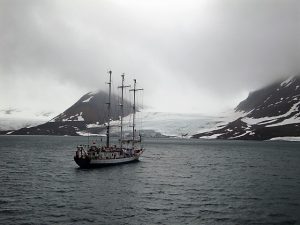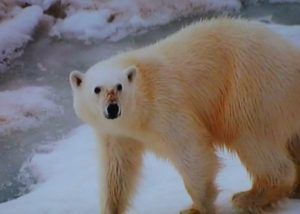The Last Polar Bear – Part 2
By Katherine Burlake
… He jumped at the sound of cracking.
 A part of the glacier across the fjord was falling as if in slow motion into the water. The boat rocked, churned up by the waves from the avalanche the locals call “white thunder.” The man looked down and saw a glint of white as a school of whales calmly swam up the fjord, apparently not disturbed by the avalanche. Their white bodies told him they were Belugas, rare but not unusual. When ice was in the fjord, the whales often were trapped in what the Inuit natives of the Arctic call a savsatt, a small opening in an expanse of ice. There the whales are easy prey for polar bears. He had never seen such a feast, only heard of them.
A part of the glacier across the fjord was falling as if in slow motion into the water. The boat rocked, churned up by the waves from the avalanche the locals call “white thunder.” The man looked down and saw a glint of white as a school of whales calmly swam up the fjord, apparently not disturbed by the avalanche. Their white bodies told him they were Belugas, rare but not unusual. When ice was in the fjord, the whales often were trapped in what the Inuit natives of the Arctic call a savsatt, a small opening in an expanse of ice. There the whales are easy prey for polar bears. He had never seen such a feast, only heard of them.
Using binoculars, he scanned the shore and the high tundra. Bears were known to take naps anywhere at any time. Napping during the day is common because their primary food, seals, hunt at night. Scientists believe naps help the bear conserve energy which is why polar bears prefer to still-hunt by sitting at the seal’s ice holes. With their size and bulky body, bears use twice the energy of other mammals to walk or run.
Looking up the ridge, he envisioned a polar bear on the grassy hillock searching for berries or sleeping on a patch of ice. On land, polar bears raid the seabird colony nesting areas of the Black Maillot and Kitty-waits for eggs. Often the bears eat bird eggs all summer. In this colony, the birds built nests on a rocky wall above the water giving them good protection from predators. The Hornsund fjord bird cliffs, home to thousands of nesting auks, rose above the boat. But at the moment the sky was empty.
Reluctantly, he realized there were no polar bears in this fjord today. It was time to head to Hinlopen Strait on the northeastern end of the nine island archipelago. If polar bears are on Svalbard Island, they should be in Hinlopen Strait.
The boat entered the strait passing by decaying foundations of whaling stations and trappers’ huts. Some weathered wooden buildings scattered along the shoreline were remnants of the nineteenth and early twentieth century expeditions to the North Pole. Above the buildings, fog shrouded the grey mountains. Today, only the glaciers and ice fields were white since the snow on the peaks had left for the summer.
The strait, like the adjacent fjords, is deeper than the Arctic sea surrounding the archipelago. The strong current running south through the aqua-marine water was flat. He thought of the Rime of the Ancient Mariner, by Samuel Taylor Coleridge. The words he remembered always haunted him when entering a pristine body of water. “The fair breeze blew, the white foam flew, the furrow free, we were the first that ever burst into that silent sea.” The boat was not the first to arrive in this strait. On the beach, a half dozen walruses rested on a sandbar. Sleeping in the summer sun, they looked well fed and easily able to spot predators. If walruses thrive, so should seals.
Radar showed ice floes ahead with one solid sheet of ice touching the shore. The water in the strait itself was full of ice floes or mini icebergs. Their tops are white and the bases reflect the fluorescent blue-green water. The ice is jagged, broken by ridges caused by the melting and moving of Arctic currents that quietly run beneath the strait. The ridges are often quite high and could hide a polar bear.
 The boat passed a large ringed seal resting on a small ice floe. The seal, basking in the sun, casually raised its head to watch the boat pass by. The boat was not a predator. Seals on the ice mean polar bears will arrive soon as the bear can smell the seals from miles away. His eyes carefully searched the ice ridges. Suddenly, the boat engines whined to a stop in the thick ice. He backed the boat around to turn toward open water. As the boat turned, he noticed a polar bear behind a ridge hunched over an ice hole.
The boat passed a large ringed seal resting on a small ice floe. The seal, basking in the sun, casually raised its head to watch the boat pass by. The boat was not a predator. Seals on the ice mean polar bears will arrive soon as the bear can smell the seals from miles away. His eyes carefully searched the ice ridges. Suddenly, the boat engines whined to a stop in the thick ice. He backed the boat around to turn toward open water. As the boat turned, he noticed a polar bear behind a ridge hunched over an ice hole.
The polar bear heard the boat and turned its head to look at them. There was a pause as the bear turned back to the ice hole. Then the polar bear rose and began its lumbering walk across the ice in the direction of the towering glacier-covered mountains. He watched the polar bear’s slow-motion walk. What did the bear see as he headed for the horizon of ice? He would never know. Nor would he ever know if he was looking at the last polar bear on Svalbard Island.
============================
 The pictures featured in this story were taken by the author as she experienced the fjord by boat.
The pictures featured in this story were taken by the author as she experienced the fjord by boat.
Post your comments below and share your stories of adventure and survival.
